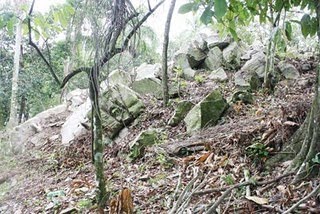Taino had no Pyramids.
Well, there is one hill before Otra Banda, close to higuey, that has a nice pyramid shape (going from Seiba to Otra Banda on the crossroad to Nisibon).
Taino architecture is based on wooden constructions of square buildings, Casas de Casique (for upper class, porch, and keeping statues of Gods) and round buildings Bohios (for lower class, preparing food etc.)
Taino words in common use are: barbecue, canoe, hammock, hurricane and tobacco.
(interesting also and not related with Tainos, is that US population use a lot word Okay, Greek origin, means All Good _ Ola Kala).
Equally unrelated and equally questionable:
THE AFRICAN THEORY
OKAY was brought to the United States by African slaves, as part of their native language. It has been claimed that the phonetic waw-kay is a phrase (or word) in either the Bantu or Wolof dialects (or both), kay being a word meaning yes and waw an emphatic; waw-kay is an emphatic yes. The use of the word kay alone is recorded in the speech of black Americans as early as 1776. Significantly, the emergence of OKAY in white Americans? vocabulary dates from a period when many refugees from Southern slavery were arriving in the North.
THE CHOCTAW THEORY
Some linguists draw attention to the Choctaw word okeh, which has the same pronunciation and meaning as in general American usage; U.S. President Woodrow Wilson, among others, used this spelling to emphasize the word?s Native American origins.
THE OLD KINDERHOOK THEORY
U.S. President Martin Van Buren was called Old Kinderhook after his birthplace of Kinderhook, New York. On March 24, 1840, during Van Buren?s bid for re-election, his Democratic supporters opened the OK Club on Grand Street in New York City?inspired by the initials of Van Buren's nickname. Van Buren lost, but OK lived on.
THE ORL KORRECT THEORY
The 1830s saw a rise in the number of quirky abbreviations of common phrases. For example, ISBD meant ?it shall be done,? RTBS ?it remains to be seen? and SP ?small potatoes.? Furthermore, KY stood for ?no use? (know yuse) and, as noted in the Boston Morning Post on March 23, 1839, OK served as shorthand for ?all correct? (orl korrect).
THE CIVIL WAR THEORY
During the Civil War, when a battalion returned from the front, the first man in line carried a sign displaying the number of men killed in action: ?9 Killed,? ?5 Killed,? and so on. If the number was zero, the sign read OK, indicating that all had survived.
THE FRENCH THEORY
One theory, published in London?s Daily Express newspaper in 1940, suggests that the term came into use during the American Revolutionary War. French sailors, remaining near their ships, patronized American women aux quais?the French term for on the docks, which is pronounced okay.
THE ANGLO-SAXON THEORY
Several centuries before okay?s first appearance, Norwegian and Danish sailors used the Anglo-Saxon term hogfor, meaning seaworthy. This was often abbreviated HG, pronounced hag-gay.
THE SHIPBUILDER THEORY
Early shipbuilders marked the timber they prepared. The first to be laid was marked OK Number 1, short for Outer Keel Number 1.
THE SCOTTISH THEORY
OK is an adaptation of the Scottish expression och-aye?deriving from och, an exclamation of surprise, and aye, meaning yes?which dates back to the 16th century.
THE OLD ENGLISH THEORY
In old England, the last harvest loads brought in from the fields were called hoacky or horkey. The same term also denoted the feast following the harvest and, thus, indicated its satisfactory completion. It was soon shortened to OK.
THE BRITISH PARLIAMENT THEORY
Some bills going through the House of Lords required the approval of Lords Onslow and Kilbracken. After reading and approving these bills, they would both initial them, producing the combined signature OK.
THE PRUSSIAN THEORY
The Prussian general Schliessen, who fought on the side of the American colonies during the Revolutionary War, was granted the title Oberst Kommandant, or Colonel-in-Command. All his orders were initialed OK.
THE GREEK THEORY
According to the text Geoponica, dated 920 CE, the Greek letters omega and khi, when repeated twice, are effective as a magical incantation against fleas.
THE SCHOOLMASTER THEORY
Early schoolmasters marked examination papers with the Latin omnis korrecta (all correct), sometimes abbreviated OK. In ancient Greece, teachers marked excellent papers with OK for ola kala, indicating all is good.
THE FINNISH THEORY
The Finnish word for correct is oikea.
THE INDIAN CHIEF THEORY
Keokuk, Iowa, is named for an Indian chief. His admirers sometimes remarked, "Old Keokuk, he's all right"; the initials OK came to mean the same thing.
THE TELEGRAPH THEORY
Telegraph operator Oscar Kent never made mistakes in his transmissions. A telegraph message signed O.K. signalled that all was correct.
THE OK / Okay THEORY
The correct spelling of OK is okay. The spelling OK constitutes historical revisionism, as all evidence points to the word okay coming from Africa and being in use long before any record of OK. See The African Theory and The Choctaw Theory
I'm with the "area 51" crowd on this story.
"Norwegian dropped his wallet" - BWAAAHAHA!!! Good one!



